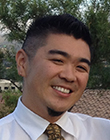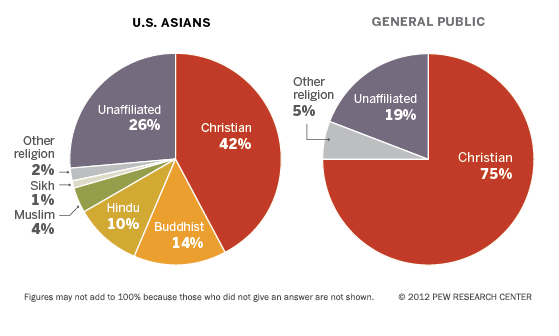Inserting Christianity into Asian American Studies
Christian Hegemony within Asian American Studies
As a young instructor of Asian American studies, I admittedly feel a bit hesitant in addressing my own experiences teaching religious studies. Rather than speaking before a classroom of students interested in studying religion (at least in theory, as many would probably attest), my students are often more concerned with taking their first steps towards individual and group empowerment as students of color. For so many of the students at Laney College—an urban community college in Oakland, California that is comprised of a working-class student body—ethnic studies courses provide them with an opportunity to learn about stories that their previous courses may have ignored. For example, rather than characterizing the Pilgrims as a group seeking religious freedom, a common ethnic studies version would be to discuss their role in the sustained genocide of American Indians.
In Asian American studies courses specifically, we have covered topics ranging from the Chinese Exclusion Act of 1882, to the forced incarceration of 120,000 Japanese Americans during World War II, to Hmong refugees still struggling to find the elusive American Dream that was promised to them more than forty years ago. For each of these three examples, our discussions inevitably include some mention of how so many different Asian American communities, at different times in the past three centuries, have suffered under the hegemonic WASP society.
For students new to Asian American studies, especially those in the San Francisco Bay Area looking to radicalize as young activists, an early course of action would be to dismantle their ties to whiteness, to male dominance, to capitalism, to heterosexism, and to Christianity. In fact, it would be quite easy for them to singularly blame Christian teachings for all of the previously listed social injustices. While today's major media networks reveal Mormon groups’ funding of anti-gay marriage campaigns and fundamentalist Christian and Catholic organizations eliminating healthcare-provided birth control, individuals on Facebook and Twitter are sharing countless links (of even less objectivity) denouncing American Christianity for its disastrous effects on everything from Filipino surnames to Hawaiian sovereignty and Korean American adoptees.
For the students of color in my classes (who are clearly in the majority), it is indeed an important moment when they realize that they can reclaim their own history and their own education. Yet, as a self-identified Japanese American Christian, whose own research coincidentally focuses on Japanese American Christianity, I am often forced to navigate a fine line between victimization and vilification while searching for legitimate scholarship and productive learning somewhere in between.
The question that arises in this situation is how to reconcile Asian American studies with Christianity. This is particularly curious and interesting in light of the recent Pew Research Survey (2012), which discovered that Christianity is the most prevalent religion among Asian American adults, with 42% identifying as such (followed by 26% unaffiliated, 14% Buddhist, and 10% Hindu). Therefore, despite characterizing Asian American studies as tending to avoid Christianity, the Asian American general public on the other hand clearly is not.
Sites of Convergence
The scholarship of Asian American studies has long had a general aversion to studying Christianity, especially due in part to the many long-term traumatic effects of Christian missionaries on Asian and Asian American communities and their direct correlation to colonization and imperialism. In the few academic texts on Asian Americans where religion is mentioned, it is often confined to a single chapter of discussion rather than interwoven into the narrative. Whereas no study of early American history would be complete without mention of the popular religious movements of the time and place (e.g., Quakers in Pennsylvania, Catholics in Maryland), I believe that it is important to apply this paradigm to the many different religious histories—including Christianity—within Asian America.
While students in Asian American studies classes rarely hesitate to question the subjectivity of assigned readings about Buddhists or practitioners of other indigenous Asian religions, there still remains a significant hurdle in establishing Asian American Christianity as a topic worthy of discussion. As an instructor, it is necessary to break down the many assumptions that students bring into the classroom, especially those based on present-day issues. But with so many different Asian American ethnic groups moving from and settling in so many various places, where can we even begin? How can I adequately cover these multiple histories in a single semester, while still including this overlooked religious element that I hold dear to my heart?
In addressing these questions, I realized that simply giving a lecture specifically about Asian American Christianity was in a sense just reinforcing it as a tangential object. Rather, I’ve begun to instead include the stories of important Asian American historical figures and writers who coincidentally identify as Christians.
For example, a man named Kanichi Miyama was one of the earliest Japanese immigrants to the United States and was instrumental in developing the Japanese communities in nineteenth century San Francisco and Hawaii. He was also well known in various religious circles for being the first Japanese American to convert to Christianity. Similarly, the early history of Korean Americans cannot be told without including the proud Christian, Syngman Rhee. David K. Yoo’s Contentious Spirits: Religion in Korean American History, 1903–1945 (2010) is an excellent example of a suitable text for a history class that will not alienate readers that are apprehensive of Christianity.
Even for a topic as radically progressive as the 1968 Third World student strikes at San Francisco State College—which led to the establishment of Asian American studies as an academic discipline—one could assign an article by Japanese American Lloyd K. Wake, “Reflections on the San Francisco State Strike” (1989). Not only was Wake incarcerated during World War II because of his ethnicity, but he is also a Methodist reverend who formerly served at Glide Church in San Francisco.
As for starting the conversation of Christianity in contemporary Asian American studies, Evan Jackson Leong’s breakout documentary Linsanity has become, perhaps for lack of a better word, a godsend. This film, while clearly about Jeremy Lin’s burgeoning career as an Asian American basketball player, also highlights his Christian faith as an integral part of his identity. These examples all illustrate Asian American Christians whose impacts have been felt far outside of their respective church walls.
A Call for Action
Asian American studies is still a relatively young field. Throughout the years, Asian American studies scholars have delved extensively into related issues such as labor, gender, sexuality, education, and psychology. Perhaps it was indeed due to its anticolonial agenda that its connections to Christianity and other branches of organized religion were often ignored. The silver lining is that there is plenty of room for growth.
I am continually amazed by the new directions of inquiry that many of my students choose to pursue for their own research projects, and in turn the new scholarship that they produce. I have also noticed a constant quest for the increasingly exotic; they are often avoiding the more studied ethnic groups (especially Chinese and Japanese) for much numerically smaller communities, refugee groups, and hybrid identities. I believe that just as students seek out less common ethnic groups, they similarly seek out less common religious identities.
Yet despite Christianity’s position as today’s most prevalent Asian American religion, the dearth of scholarship in the field is quite apparent. While it is important to continue to expand the boundaries of study, we should also encourage our students to fill in the considerable gaps that still exist. Even if a student were to only mention that a particular individual attended a Christian Sunday school as a child, such seemingly inconsequential facts as this can and will contribute to normalizing Christianity’s place in Asian American studies.
Today's Asian American Christian churches offer a trove of potential research topics, both in terms of studying race and religion, but more importantly, in terms of studying where and how people interact and become a community. Through our collective encouragement to pursue new transdisciplinary research projects, we can not only contribute to our respective fields, but we can also build a connecting “middle ground” for future comparative research.
 Dean Ryuta Adachi is a PhD candidate in US history at Claremont Graduate University and lecturer of Asian American history at Laney College in Oakland, California; his research focuses on early Japanese American Christianity. He has also taught courses on Asian American youth, Asian American hip-hop, and Asian American films. He is active in the San Francisco Bay Area Asian American community and volunteers weekly at the Japanese American Museum of San Jose.
Dean Ryuta Adachi is a PhD candidate in US history at Claremont Graduate University and lecturer of Asian American history at Laney College in Oakland, California; his research focuses on early Japanese American Christianity. He has also taught courses on Asian American youth, Asian American hip-hop, and Asian American films. He is active in the San Francisco Bay Area Asian American community and volunteers weekly at the Japanese American Museum of San Jose.

